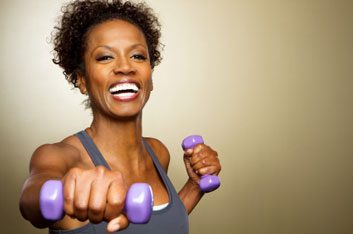
Build muscle strength today
Women are at several disadvantages when it comes to optimal muscle health. With age, our muscles deteriorate at a faster rate than men’s, explains Michael Bemben, an exercise physiologist and professor in the department of health and exercise science at the University of Oklahoma. The neurons that control muscles in both genders are programmed to die off with age. “Men typically have more muscle to begin with so they can afford to lose some, whereas women can’t,” he adds.
It’s also more difficult for women to replace lost muscle than it is for men. A study in the journal PLoS One found older women have less effective muscle protein synthesis-the process that breaks down food to build muscle-than men. So the researchers advise us to eat enough protein.
We also need power, endurance and strength. Older women saw only a 10 percent increase in muscle power versus a 50 percent rise for younger women doing comparable exercises, according to a study in Medicine & Science in Sports & Exercise. Power is more closely related to the ability to perform daily activities and reduce the risk of falls than muscle strength alone, states Dain LaRoche, the study’s co-author and assistant professor of exercise science in the department of kinesiology at the University of New Hampshire.
The good news? With exercise, older women can build up muscle strength. But to achieve “net muscle gain,” we need to work on improving our muscle health now, says Jennifer Jakobi, an assistant professor in the school of human kinetics at the University of British Columbia. “It’s like retirement savings: The more you invest in your muscles, the larger the base you have to function longer.”
Here are the four key target zones you should exercise now, so that as you age you can golf and garden without pain-and travel the world without a walker.
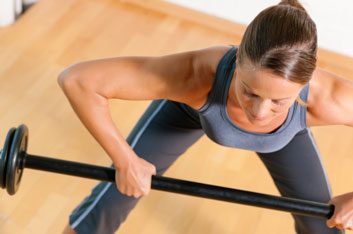
The upper body
Why it’s important: As women age, we lose the most muscle in our lower limbs, including thighs, hamstrings and calves, but we typically notice functional problems in our upper bodies first. “We walk around all day carrying our body weight, which works out our legs,” explains Rick Kaselj, a kinesiologist and personal trainer in Surrey, B.C. “But as we get older, we don’t push or lift things as much.” Strong trapezius, deltoid, biceps and triceps muscles could someday make a difference doing basic tasks such as carrying groceries or your grandkids. And the weaker they are, the more prone you are to neck strain, says Kaselj. “Our arm, shoulder and neck muscles are all interconnected.”
Exercises that work: To maintain upper body strength, the push-up is the best all-round upper body exercise. Kaselj recommends both wall push-ups (the farther away your feet are from the wall, the tougher the push-up) and floor push-ups (on your knees is fine, though toes are better). Do 10 on the wall and 10 on the floor daily.
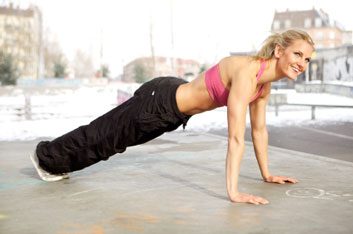
The core
Why it’s important: We usually think of the core muscles as only the rectus abdominis (the muscle that makes up a “six-pack”). But there are deeper muscle layers, including the internal and external oblique, transversus abdominis and multifidus muscles, that need to be strong to avoid placing extra strain on our much-imposed-upon lower back. A little prevention goes a long way for back pain, which makes even the most basic tasks, like sitting or bending over, excruciating. To target all the core muscles, activate them during a workout. “Tense them as though you are bracing to be punched in the stomach,” explains Sherry Swanburg, a certified exercise physiologist in Kentville, N.S.
Exercises that work: Swanburg recommends the forearm plank, which strengthens and builds endurance in key core muscles. Lie face down on the floor (on a carpet or yoga mat), resting on your forearms with your elbows tucked into your sides. Raise your body on your forearms and toes, and hold it in a straight line for 10 to 30 seconds, being careful not to let your knees or hips sink, or to raise or lower your head out of line with your back (look down at the floor). Gradually build up the duration until you can hold for the full 30 seconds. Do four daily.
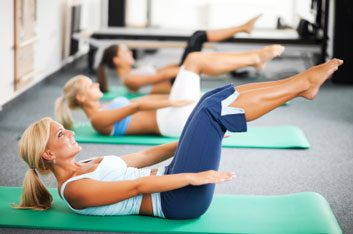
The pelvis
Why it’s important: Pelvic floor muscles, the sling of muscles that connect the pubic bone and tailbone, are responsible for maintaining sexual, bladder and bowel function, supporting organs and facilitating the actions of the spine and legs. Women are susceptible to weakness in this area, particularly after childbirth. “We tend not to concentrate on these muscles,” says Amy Stein, a New York physical therapist who specializes in pelvic pain and is the author of Heal Pelvic Pain. “But any dysfunction in the pelvic floor could cause dysfunction in the bowel or bladder, such as incontinence, and painful sex.”
Exercises that work: Dr. Sheila Dugan, an assistant professor of physical medicine and rehabilitation at the Rush University Medical Center in Chicago, recommends two exercises for pelvic muscles, including the coccygeus and levator ani: Lie on your back with bent knees, feet on the floor, and then smoothly draw in lower belly muscles as though you are wearing a girdle or corset. Hold for a count of five, then slowly release. Do 10 of these twice daily.
For a second exercise, lie on your back, and lift the internal pelvic muscles in and up (your hips don’t actually come off the floor) for a count of five, then slowly lower for a count of five. Repeat as often as possible during the day.
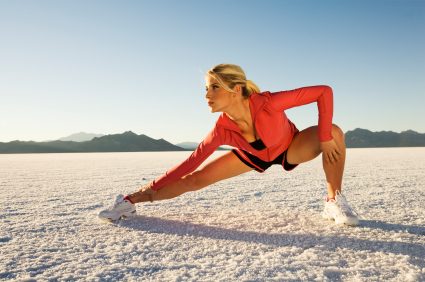
The knees
Why it’s important: While a knee contains tendon, not muscle, the strength of your leg and hip muscles-even the gluteus maximus and, in particular, the hamstrings-plays a key role in stability, and in preventing knee strain and injury. Women’s knees are more susceptible to injury than men’s because our wider hips create a stressful hip-to-knee V-angle, and our propensity for wearing high heels shifts our weight forward onto our knees. Knee pain can be disabling, making it painful even to walk across the living room. But don’t bother hitting the elliptical machine to target hamstrings and glutes, advises kinesiologist Kaselj. “It doesn’t work them out at all.”
Exercises that work: Target your hamstring muscles with a simple leg curl: Lie on your stomach. Slowly bring your right heel toward to your bum, then slowly return it to the floor. Repeat the move using left leg. Do 10 with each leg per day.
Also, work your glutes with a leg lift: Lie on your stomach, and lift one leg straight out behind you so your thigh is off the floor. Return to floor. Do 10 with each leg per day.
Related:
• Vitamin needs at every age
• 9 moves for strong, sexy legs
• How to ease muscle pain after exercise
